Influence of Surface Preprocessing on 4H-SiC Wafer Slicing by Using Ultrafast Laser
Abstract
:1. Introduction
2. Experimental Equipment and Material
3. Results
3.1. H-SiC Absorption Spectrum Test
3.2. Effect of Surface Preprocessing on Surface Damage and Modified Layer
3.3. Tensile Test after the Laser Processing
3.4. The Morphologies Test of the Modified Layer and Cleavage Area
3.5. Elemental Analysis of Stripping Interface
4. Conclusions
Author Contributions
Funding
Data Availability Statement
Acknowledgments
Conflicts of Interest
References
- Kirschman, R. Status of Silicon Carbide (SiC) as a WideBandgap Semiconductor for High Temperature Applications: A Review. Solid-State Electron. 1996, 39, 1409–1422. [Google Scholar] [CrossRef]
- Dohnke, K.O.; Kaspar, K.; Lewke, D. Comparison of Different Novel Chip Separation Methods for 4H-SiC. Mater. Sci. Forum 2015, 821–823, 520–523. [Google Scholar] [CrossRef]
- Ohmura, E.; Fukuyo, F.; Fukumitsu, K.; Morita, H. Internal modified-layer formation mechanism into silicon with nanosecond laser. J. Achiev. Mater. Manuf. Eng. 2006, 17, 381–384. [Google Scholar] [CrossRef] [Green Version]
- Wang, L.; Zhang, C.; Liu, F.; Zheng, H.; Cheng, G.J. Process mechanism of ultrafast laser multi-focal-scribing for ultrafine and efficient stealth dicing of SiC wafers. Appl. Phys. A 2022, 128, 872. [Google Scholar] [CrossRef]
- Xie, X.; Zhang, Y.; Huang, Q.; Huang, Y.; Zhang, W.; Zhang, J.; Long, J. Monitoring method for femtosecond laser modification of silicon carbide via acoustic emission techniques. J. Mater. Process. Technol. 2020, 290, 116990. [Google Scholar] [CrossRef]
- Fukuyo, F.; Fukumitsu, K.; Uchiyama, N. The Stealth Dicing Technologies and Their Application. In Proceedings of the 6th International Symposium on Laser Precision Microfabrication, Williamsburg, VA, USA, 4–8 April 2005. [Google Scholar]
- Zhang, Z.; Wen, Z.; Shi, H.; Song, Q.; Xu, Z.; Li, M.; Hou, Y.; Zhang, Z. Dual laser beam asynchronous dicing of 4H-sic wafer. Micromachines 2021, 12, 1331. [Google Scholar] [CrossRef] [PubMed]
- Bulgakova, N.M.; Burakov, I.M.; Meshcheryakov, Y.P.; Stoian, R.; Rosenfeld, A.; Hertel, I.V. Theoretical models and qualitative interpretation of fs laser material processing. J. Laser Micro/Nano Eng. 2007, 2, 76–86. [Google Scholar] [CrossRef]
- Jiang, L.; Tsai, H.L. Energy transport and material removal in wide bandgap materials by a femtosecond laser pulse. Int. J. Heat Mass Transf. 2005, 48, 487–499. [Google Scholar] [CrossRef]
- Pecholt, B.; Vendan, M.; Dong, Y.; Molian, P. Ultrafast laser micromachining of 3C-SiC thin films for MEMS device fabrication. Int. J. Adv. Manuf. Technol. 2008, 39, 239–250. [Google Scholar] [CrossRef]
- Rethfeld, B.; Sokolowski-Tinten, K.; Von Der Linde, D.; Anisimov, S.I. Timescales in the response of materials to femtosecond laser excitation. Appl. Phys. A 2004, 79, 767–769. [Google Scholar] [CrossRef]
- Kim, E.; Shimotsuma, Y.; Sakakura, M.; Miura, K. Ultrashort Pulse Laser Slicing of Wide Bandgap 4H-SiC Crystal. In JSAP-OSA Joint Symposia 2016 Abstracts; Optica Publishing Group: Washington, DC, USA, 2016. [Google Scholar]
- Kim, E.; Shimotsuma, Y.; Sakakura, M.; Miura, K. 4H-SiC wafer slicing by using femtosecond laser double-pulses. Opt. Mater. Express 2017, 7, 2450–2460. [Google Scholar] [CrossRef]
- Hirata, K. New Laser Slicing Technology Named KABRA Process Enables High Speed and High Efficiency SiC Slicing. In Proceedings of the Conference on Laser-Based Micro- and Nanoprocessing, Tokyo, Japan, 30 January–1 February 2018. [Google Scholar]
- Swoboda, M.; Beyer, C.; Rieske, R.; Drescher, W.; Richter, J. Laser assisted sic wafer using cold split. Mater. Sci. Forum 2017, 897, 403–406. [Google Scholar] [CrossRef]
- Swoboda, M.; Rieske, R.; Beyer, C.; Ullrich, A.; Gesell, G.; Richter, J. Cold Split Kerf-Free Wafering Results for Doped 4h-Sicboules. Mater. Sci. Forum 2019, 963, 10–13. [Google Scholar] [CrossRef]
- Han, S.; Yu, H.; He, C.; Zhao, S.; Ning, C.; Jiang, L.; Lin, X. Laser slicing of 4h-sic wafers based on picosecond laser-induced micro-explosion via multiphoton processes. Opt. Laser Technol. 2022, 154, 108323, ISSN 0030-3992. [Google Scholar] [CrossRef]
- Dresselhaus, M.S.; Jorio, A.; Hofmann, M.; Dresselhaus, G.; Saito, R. Perspectives on Carbon Nanotubes and Graphene Raman Spectroscopy. Nano Lett. 2010, 10, 751–758. [Google Scholar] [CrossRef] [PubMed]
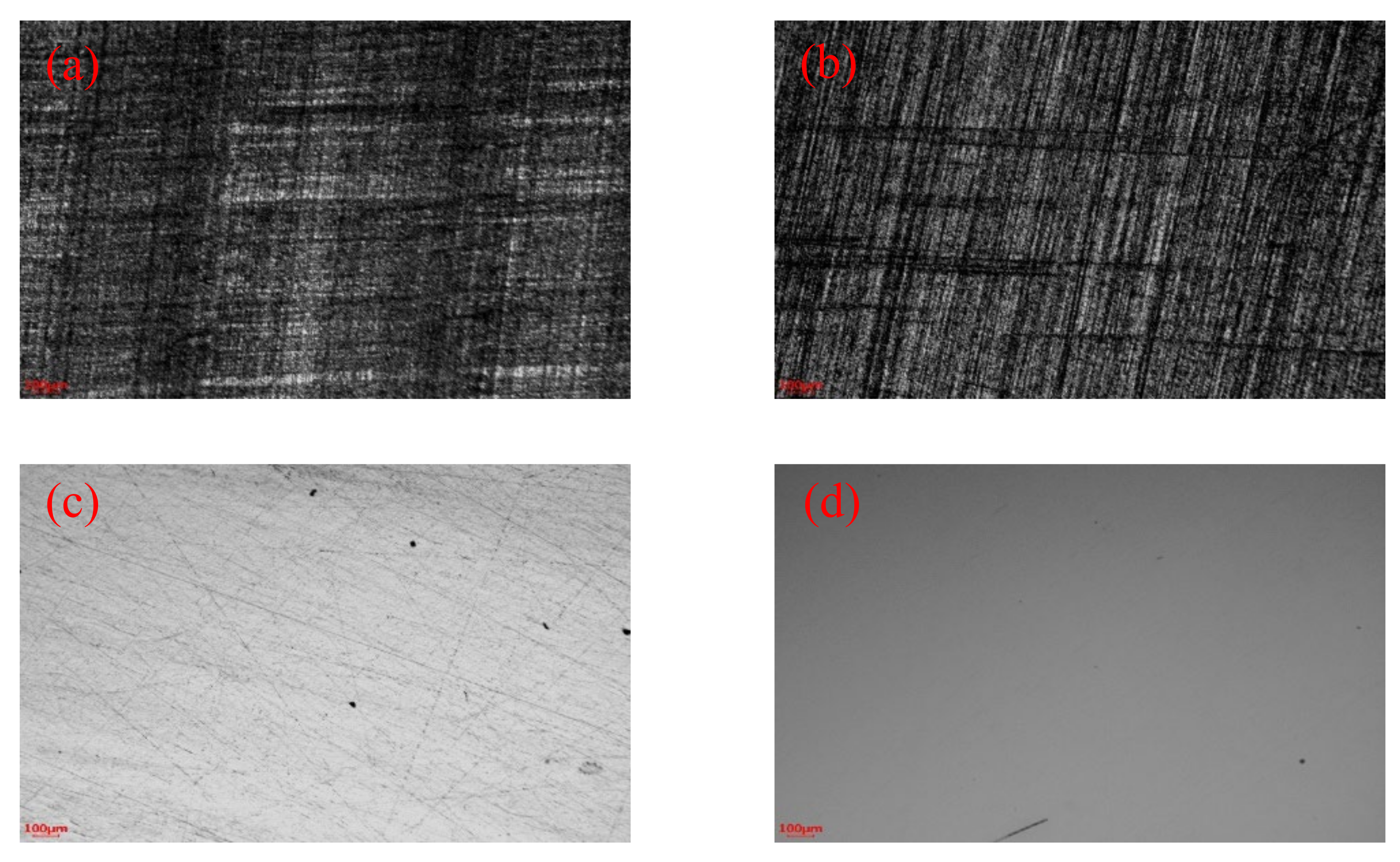


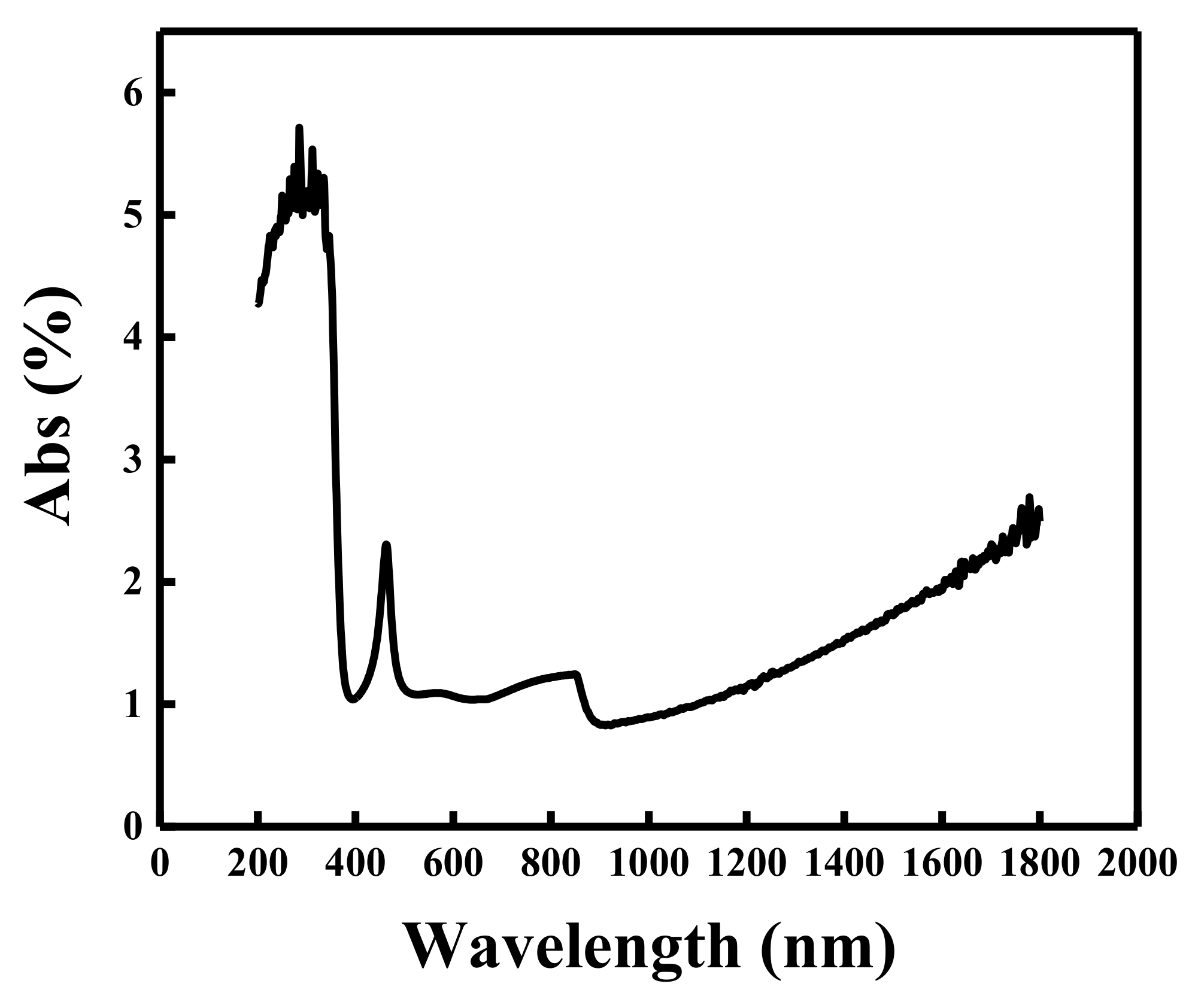


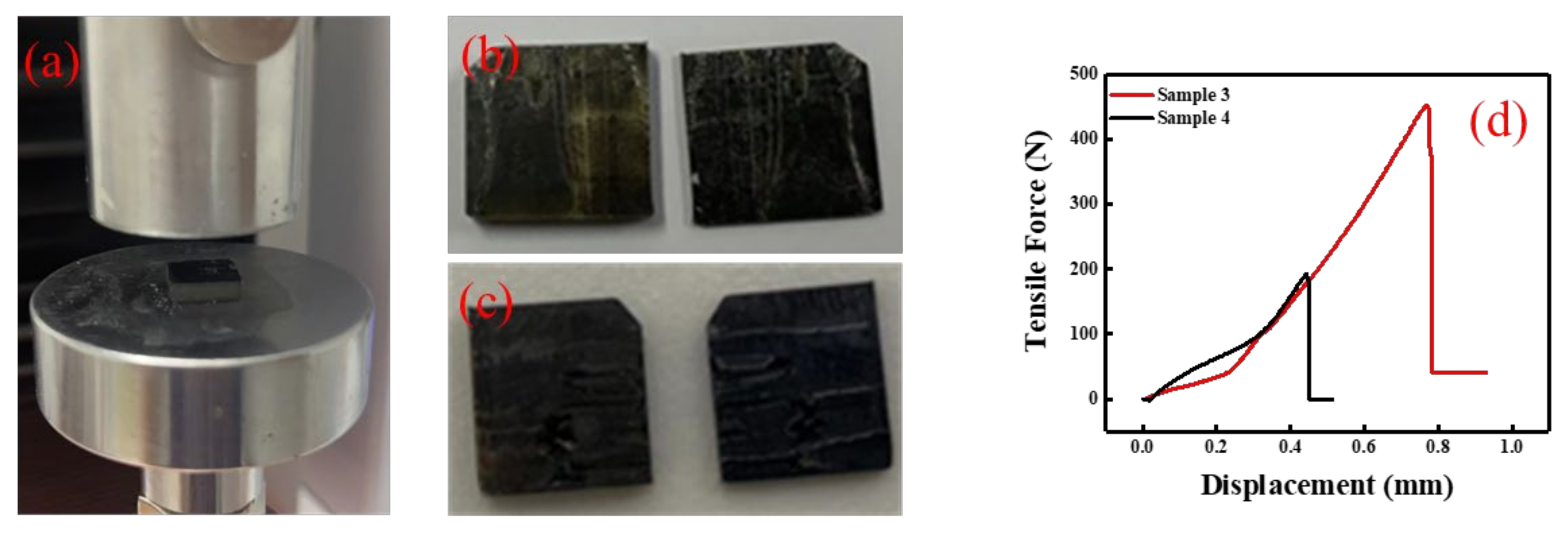

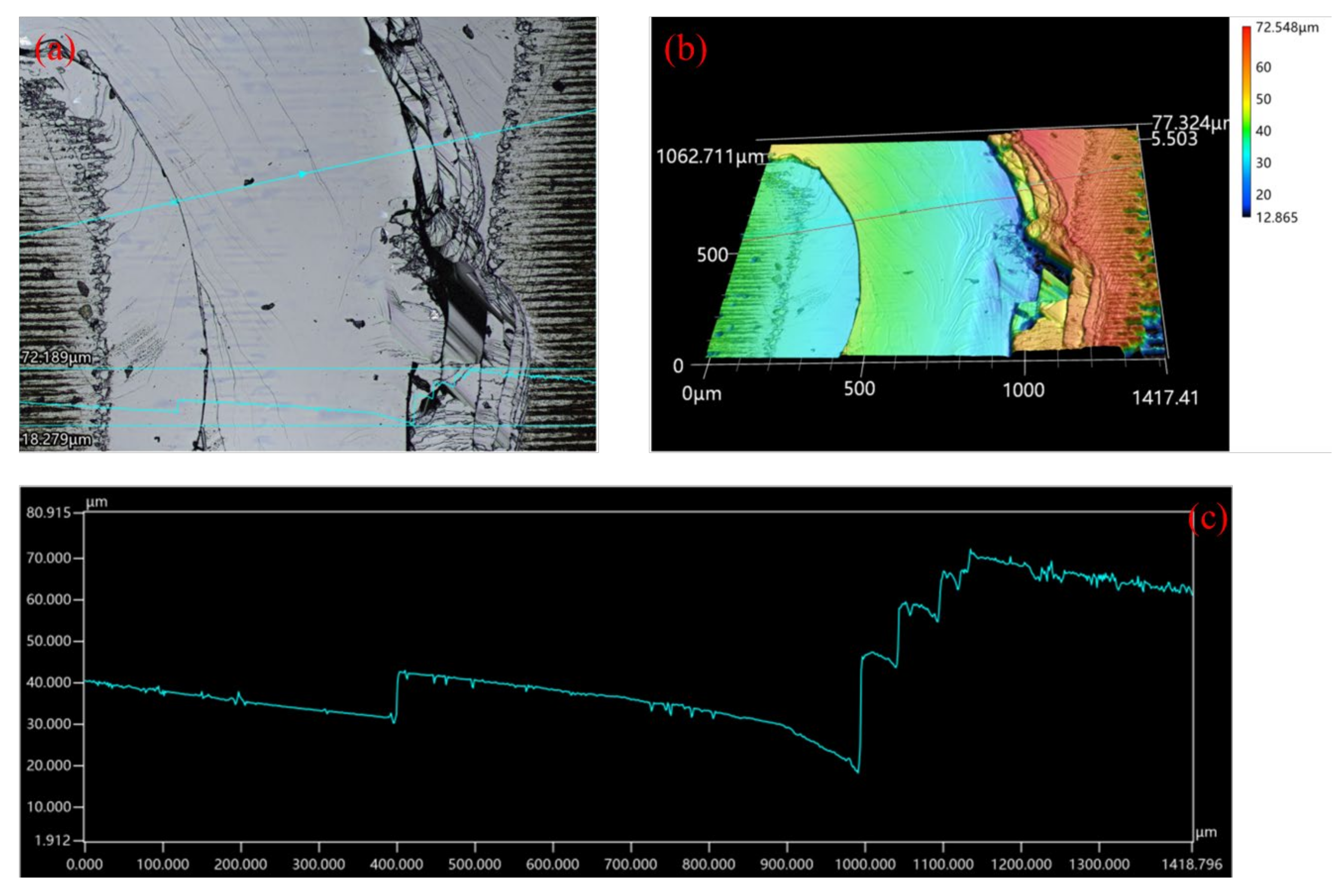

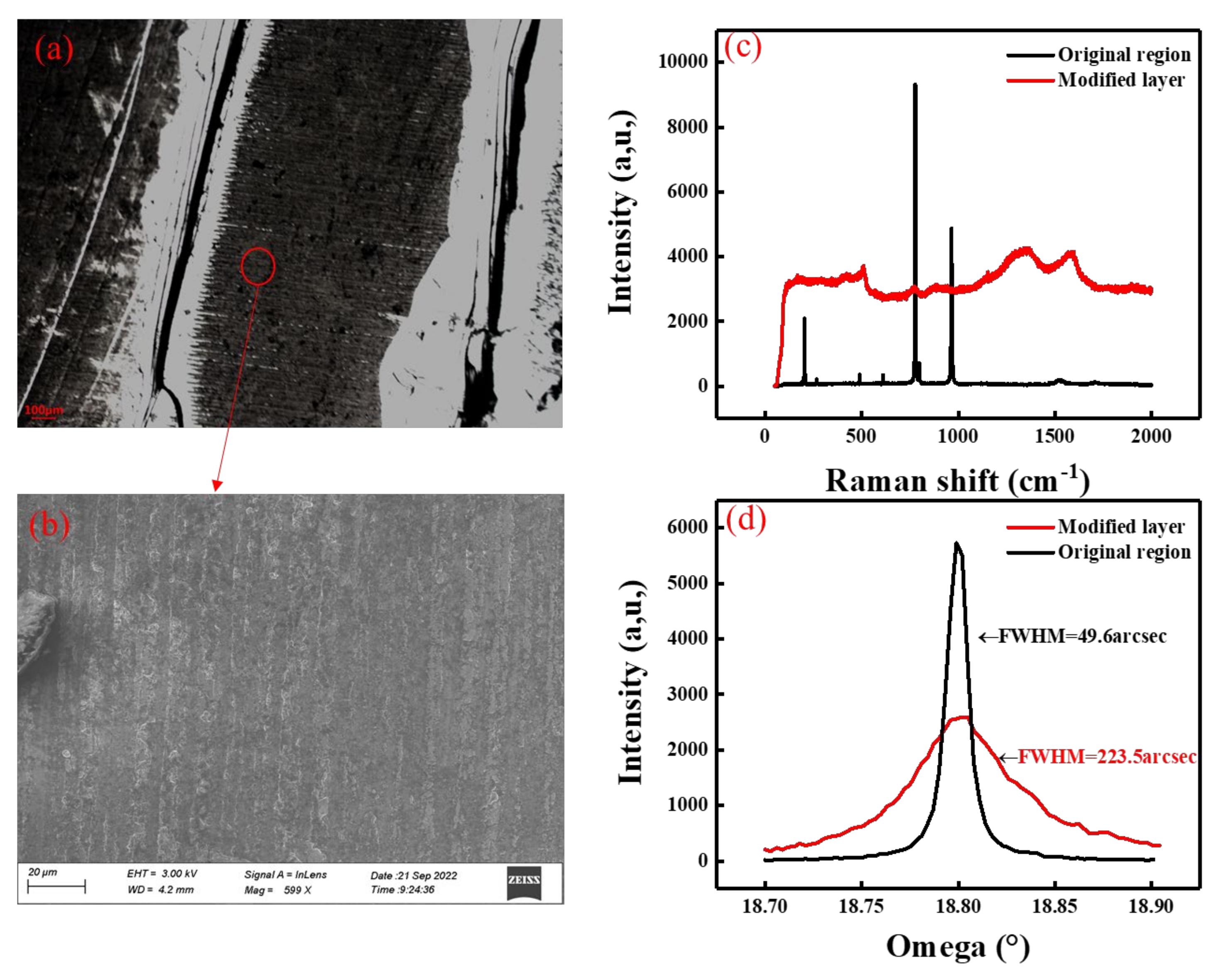
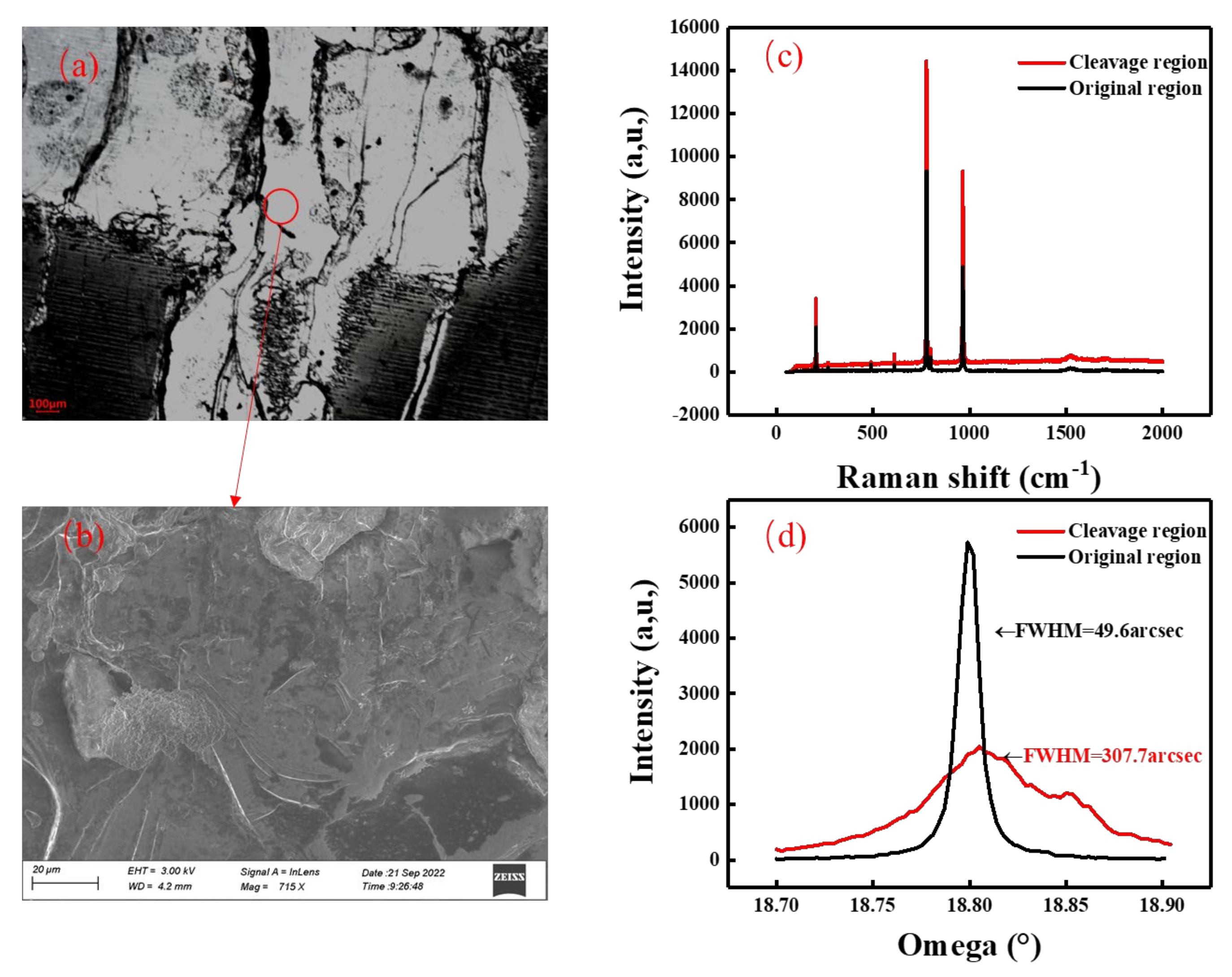
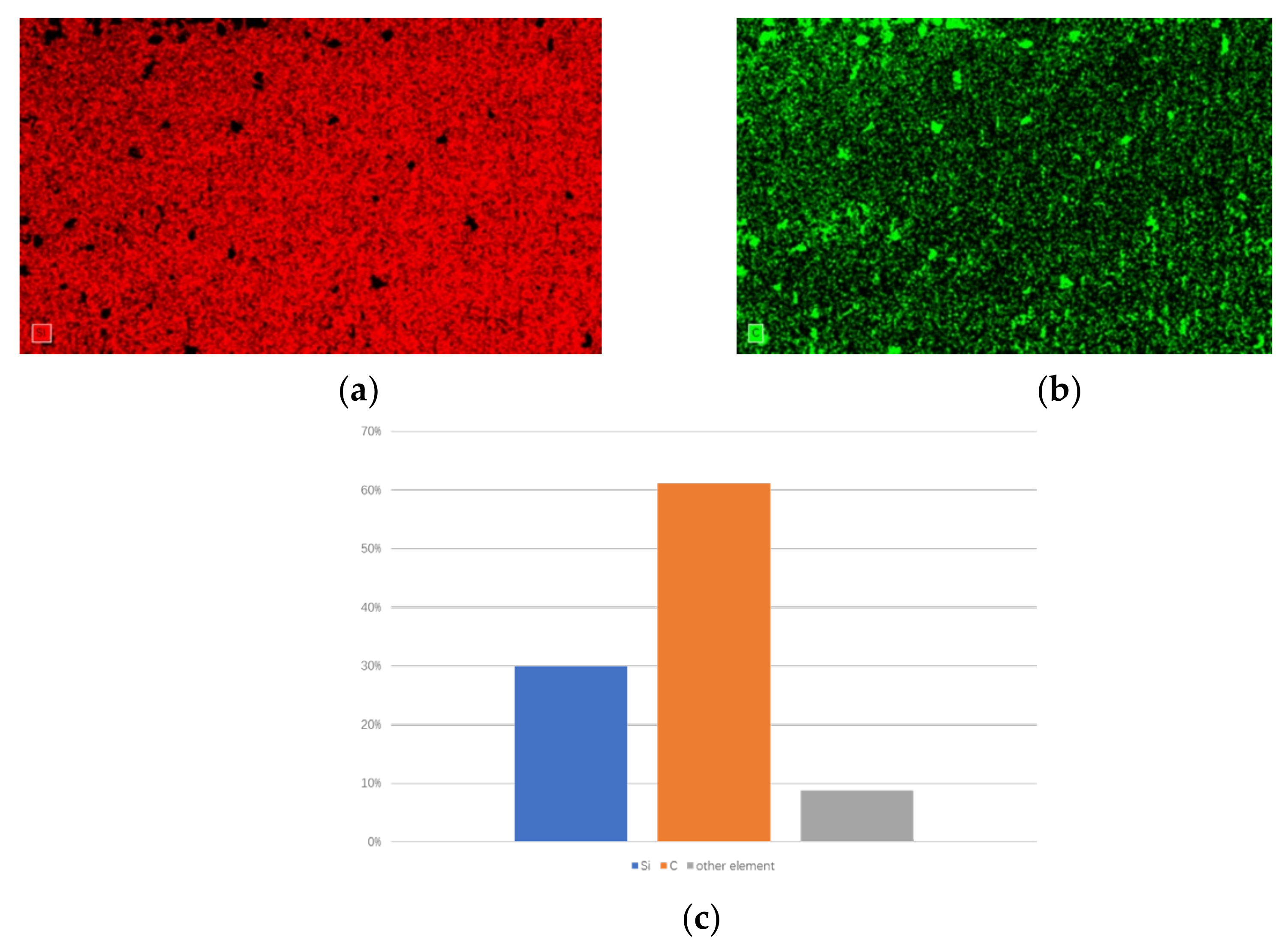
Disclaimer/Publisher’s Note: The statements, opinions and data contained in all publications are solely those of the individual author(s) and contributor(s) and not of MDPI and/or the editor(s). MDPI and/or the editor(s) disclaim responsibility for any injury to people or property resulting from any ideas, methods, instructions or products referred to in the content. |
© 2022 by the authors. Licensee MDPI, Basel, Switzerland. This article is an open access article distributed under the terms and conditions of the Creative Commons Attribution (CC BY) license (https://creativecommons.org/licenses/by/4.0/).
Share and Cite
Wang, H.; Chen, Q.; Yao, Y.; Che, L.; Zhang, B.; Nie, H.; Wang, R. Influence of Surface Preprocessing on 4H-SiC Wafer Slicing by Using Ultrafast Laser. Crystals 2023, 13, 15. https://doi.org/10.3390/cryst13010015
Wang H, Chen Q, Yao Y, Che L, Zhang B, Nie H, Wang R. Influence of Surface Preprocessing on 4H-SiC Wafer Slicing by Using Ultrafast Laser. Crystals. 2023; 13(1):15. https://doi.org/10.3390/cryst13010015
Chicago/Turabian StyleWang, Hanwen, Qiu Chen, Yongping Yao, Linlin Che, Baitao Zhang, Hongkun Nie, and Rongkun Wang. 2023. "Influence of Surface Preprocessing on 4H-SiC Wafer Slicing by Using Ultrafast Laser" Crystals 13, no. 1: 15. https://doi.org/10.3390/cryst13010015




